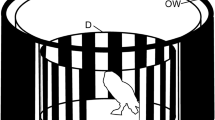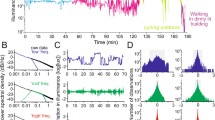Summary
The nine crista/cupula sections (C1–C9) that form the angular acceleration receptor system ofOctopus vulgaris can be divided into two subsystems on the basis of cupula size. Electrophysiological recordings were made from representatives (C1 and C2) of these two sub-systems to determine their functional response characteristics.
-
1.
With the statocyst stationary in the normal upright position, 62% of the afferent units from erista section C2, which has a large cupula, displayed a resting level of activity. None of the afferent units from erista section C1, which has a small cupula, showed resting activity.
-
2.
The dynamic responses of the C1 and C2 units were examined during sinusoidal oscillations of the statocyst in the pitch plane at stimulus frequencies between 0.01 and 1.6 Hz, and with amplitudes between 3° and 35°. Both the C1 and C2 units showed linear increases in their responses with increasing stimulus amplitudes (Fig. 5). The threshold frequency at which a unit first responded was found to be an order of magnitude lower for the C2 units in comparison to the C1 units (Fig. 9). At a stimulus frequency of 1.6 Hz, 40% of the C2 units showed a saturation in their responses. None of the C1 units showed signs of response saturation at this frequency.
-
3.
The gain values of the C1 and C2 units decreased with increasing stimulus frequency; the C1 values were higher than the C2 values (Fig. 7). The phase lag values, with respect to peak angular acceleration, were lower for C2 units compared with C1 units (Fig. 8). The phase lag values of both types of unit increased with increasing stimulus frequency but, in the middle frequency range, showed a plateau level at 100° for the C1 units and between 80° and 90° for the C2 units (Fig. 8). This indicates that in the middle frequency range the units code angular velocity. Both phase and gain values were affected by changes in the orientation of the statocyst with respect to gravity (Fig. 12).
-
4.
All of the units analysed in this report originated from ventrally polarized receptor cells. However, during large amplitude oscillations, responses from dorsally polarized receptor units were also observed (Fig. 13).
-
5.
These results demonstrate that the octopus angular acceleration receptor system is divided into two sub-systems of differing sensitivities and that the dynamic response characteristics of the system show close parallels with those of the vertebrate semicircular canal system.
Similar content being viewed by others
References
Anderson JH, Blanks RHI, Precht W (1978) Response characteristics of semicircular canal and otolith systems in cat. 1 Dynamic responses of primary vestibular fibres. Exp Brain Res 32:491–507
Anliker M, Buskirk W van (1971) The role of perilymph in the response of the semicircular canals to angular accelerations. Acta Otolaryngol 72:93–100
Barber VC (1968) The structure of mollusc statocysts, with particular reference to cephalopods. Symp Zool Soc Lond 23:37–62
Blanks RHI, Precht W (1976) Functional characterization of primary vestibular afferents in the frog. Exp Brain Res 25:369–390
Budelmann BU (1970) Die Arbeitsweise der Statolithenorgane vonOctopus vulgaris. Z Vergl Physiol 70:278–312
Budelmann BU (1976) Equilibrium receptor systems in molluscs. In: Mill PJ (ed) Structure and function of proprioceptors in the invertebrates. Chapman and Hall, London, pp 529–566
Budelmann BU (1977) Structure and function of the angular acceleration receptor systems in the statocysts of cephalopods. Symp Zool Soc Lond 38:309–324
Budelmann BU, Wolff HG (1973) Gravity response from angular acceleration receptors inOctopus vulgaris. J Comp Physiol 85:283–290
Budelmann BU, Sachse M, Staudigl M (1985) The angular acceleration receptor system of the statocyst ofOctopus vulgaris: Morphometry, ultrastructure, and neuronal and synaptic organization. Phil Trans R Soc Lond (in press)
Dijkgraaf S (1961) The statocyst ofOctopus vulgaris as a rotation receptor. Publ Staz Zool Napoli 32:64–87
Fernandez C, Goldberg JM (1971) Physiology of peripheral neurons innervating semicircular canals of the squirrel monkey. II. Response to sinusoidal stimulation and dynamics of peripheral vestibular system. J Neurophysiol 34:661–675
Goldberg JM, Fernandez C (1971) Physiology of peripheral neurons innervating semicircular canals of the squirrel monkey. III. Variations among units in their discharge properties. J Neurophysiol 34:676–684
Goldberg JM, Fernandez C (1977) Conduction times and background discharge of vestibular afferents. Brain Res 112:545–550
Govardovskii VI (1971) Some characteristics and dynamics of the endolymph in cephalopod statocysts. J Evol Biochem Physiol 7:347–351
Groen JJ, Lowenstein O, Vendrik AJH (1952) The mechanical analysis of the responses of the horizontal semicircular canal in the isolated labyrinth. J Physiol 117:329–346
Hartmann R, Klinke R (1980) Discharge properties of afferent fibres of the goldfish semicircular canal with high frequency stimulation. Pflügers Arch 388:111–121
Henn V, Cohen B, Young LR (1980) Visual-vestibular interaction in motion perception and the generation of nystagmus. Neurosci Res Prog Bull 18:459–651
Jones MG, Milsum JH (1970) Characteristics of neural transmission from the semicircular canal to the vestibular nuclei of cats. J Physiol 209:295–316
Keller EL (1976) Behaviour of horizontal semicircular canal afferents in alert monkey during vestibular and optokinetic stimulation. Exp Brain Res 24:459–471
Landolt JP, Correia MJ (1980) Neurodynamic response analysis of anterior semicircular canal afferents in the pigeon. J Neurophysiol 43:1746–1770
Louis AW, Kimm J (1976) The responses of 8th nerve fibres to horizontal sinusoidal oscillation in alert monkey. Exp Brain Res 24:447–457
Maddock L, Young JZ (1984) Some dimensions of the angular acceleration receptor systems of cephalopods. J Mar Biol Assoc UK 64:55–79
Maturana HR, Sperling S (1963) Unidirectional response to angular acceleration recorded from the middle erista nerve in the statocyst ofOctopus vulgaris. Nature 197:815–816
Messenger JB (1969) The effects on locomotion of lesions to the visuo-motor system inOctopus. Proc R Soc Lond B 167:252–281
Milsum JH (1966) Biological control systems analysis. McGraw-Hill, New York
O'Leary DP, Dunn RF, Honrubia V (1974) Functional and anatomical correlation of afferent responses from the isolated semicircular canal. Nature 251:225–227
Precht W (1978) Neuronal operations in the vestibular system. Studies of brain function, vol 2. Springer, Berlin Heidelberg New York
Sandeman DC, Okajima A (1972) Statocyst-induced eye movements in the crabScylla serrata. I. The sensory input from the statocysts. J Exp Biol 57:187–204
Stephens PR, Young JZ (1978) Semicircular canals in squids. Nature 271:444–445
Vinnikov YaA, Gasenko OG, Bronstein AA, Tsirulis TP, Ivanov VP, Pyatkina GA (1967) Structural, cytochemical and functional organization of statocysts of Cephalopoda. Symposium of neurobiology of invertebrates: 29–48. Akadamiai Kiado, Budapest
Wilson VJ, Jones GM (1979) Mammalian vestibular physiology. Plenum, New York London
Young JZ (1960) The statocyst ofOctopus vulgaris. Proc R Soc Lond B 152:3–29
Author information
Authors and Affiliations
Rights and permissions
About this article
Cite this article
Williamson, R., Budelmann, B.U. The response of theOctopus angular acceleration receptor system to sinusoidal stimulation. J. Comp. Physiol. 156, 403–412 (1985). https://doi.org/10.1007/BF00610733
Accepted:
Issue Date:
DOI: https://doi.org/10.1007/BF00610733




